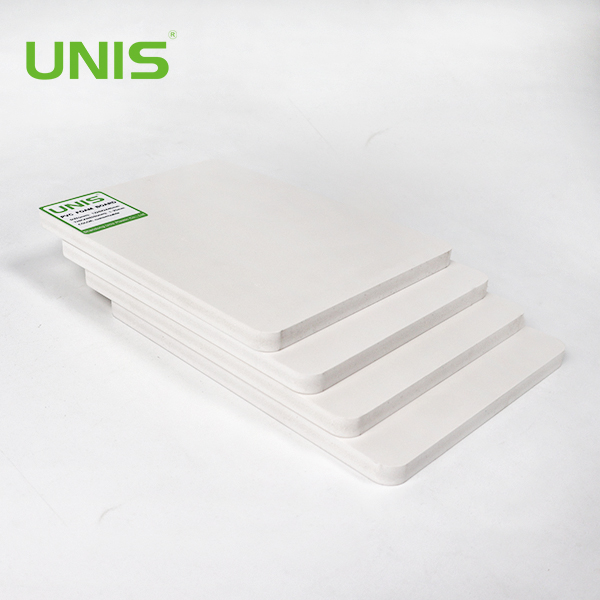Views: 0 Author: Unis Factory Publish Time: 2025-04-14 Origin: www.unis-factory.com









In construction, furniture manufacturing, and signage production, materials often face exposure to water, humidity, or damp environments. This makes water resistance an essential factor when selecting building materials. Among various options, PVC foam boards are widely known for their durability, versatility, and surface finish. But a common question that businesses ask is: Are PVC foam boards fully waterproof, or are they simply water-resistant?
At Unis Factory, one of China's top plastic sheet manufacturers, we provide premium PVC foam boards, acrylic sheets, WPC sheets, and polycarbonate sheets. With over three decades of experience and 35 production lines producing 2,100 tons of plastic sheets monthly, we understand exactly how these materials perform under real-world conditions. This article explores the waterproofing capabilities of PVC foam boards in detail, to help you make informed choices for your business.
PVC (polyvinyl chloride) foam boards are made by mixing PVC resin with additives and blowing agents, resulting in a lightweight, closed-cell structure. This means the internal cells are sealed, not allowing moisture to pass through them. Unlike wood or paper-based materials, PVC does not absorb water or degrade when exposed to moisture over time. This is one of the reasons why PVC foam boards are used in applications where water exposure is likely.
To clarify the terminology:
Water-resistant materials can resist the penetration of water to some extent but are not completely impervious.
Waterproof materials, on the other hand, do not allow any water to pass through and offer complete protection from moisture.
PVC foam boards fall under the waterproof category due to their non-porous, closed-cell structure, which prevents water absorption. They do not swell, crack, rot, or lose structural integrity even when subjected to prolonged moisture or humidity.
PVC foam boards are manufactured with a structure that does not allow water molecules to penetrate. This makes them ideal for applications such as bathrooms, kitchens, exterior wall panels, and marine environments.
PVC is a non-hygroscopic material, which means it does not absorb moisture from the air or liquid water. This further reinforces its use in humid climates or areas with direct water contact.
Because water cannot enter the material, mold and mildew cannot develop within or on the board’s surface. This makes PVC foam boards highly suitable for healthcare environments, commercial kitchens, and wet-area furniture.
Waterproofing goes beyond just resisting water. PVC foam boards are chemically stable and do not break down or weaken when in contact with cleaning solutions, detergents, or even saltwater. This enhances their performance in industrial and coastal applications.

In kitchen environments, steam, splashes, and spills are frequent. PVC foam boards are used to fabricate cabinet panels, drawer backs, and structural partitions due to their waterproof performance.
PVC foam boards are a go-to material for vanities, mirror frames, and bathroom wall cladding. Even with constant humidity, the boards maintain their shape and finish without warping.
Rain and environmental exposure can damage traditional signage materials. PVC foam boards remain intact and vibrant even after heavy rain, making them ideal for outdoor advertising boards.
Waterproof ceiling panels in humid regions are often made using PVC foam boards. They provide a clean, mold-resistant solution that lasts longer than gypsum or wood-based boards.
Compared to MDF (medium-density fiberboard) or plywood, which absorb water and deform over time, PVC foam boards outperform them significantly in moist conditions. They also resist corrosion, unlike metal sheets, and are more durable than laminated particle boards when exposed to water.
While some water-resistant wood panels use coatings or laminates to achieve temporary water protection, these coatings wear off over time. PVC foam boards, however, are intrinsically waterproof, meaning the protection is inherent and permanent.
While PVC foam boards are waterproof, it is still important to install them properly. Use appropriate adhesives and sealants in high-moisture applications to prevent water from seeping through seams or joints. Make sure to use UV-stabilized versions for long-term outdoor use to avoid discoloration or degradation from sunlight.

PVC foam boards are not just water-resistant—they are fully waterproof, thanks to their non-porous, closed-cell design and inherent chemical stability. This makes them one of the most reliable materials for interior and exterior applications that demand moisture resistance and long-term durability.
Whether you're in the construction industry, furniture manufacturing, or signage business, choosing waterproof materials can make a significant difference in product lifespan and performance. Unis Factory is proud to offer a wide range of PVC foam board sizes, thicknesses, and color options to suit your business needs. While we do not offer customization services, our catalog includes a versatile selection to support bulk purchasing for large-scale projects.
For waterproof performance you can trust, choose PVC foam boards from a factory that understands quality and consistency.